← Older posts
News
9 May 2025
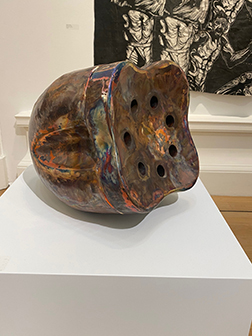
‘Carbon Capture’ at the 199th Royal Scottish Academy Annual Exhibition 2025 at the RSA in Edinburgh (Gallery 3).
The work evokes issues of shifting climatic change and consequence in the balance between the natural and the man-made.
The RSA annual exhibition, Saturday 3rd May to Sunday 8th June 2025 at the RSA, The Mound, Edinburgh.
RSA 199th Annual Exhibition
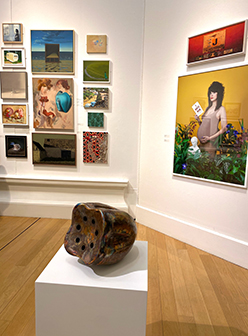
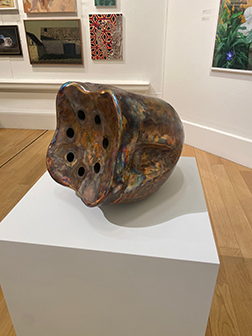
28 April 2025
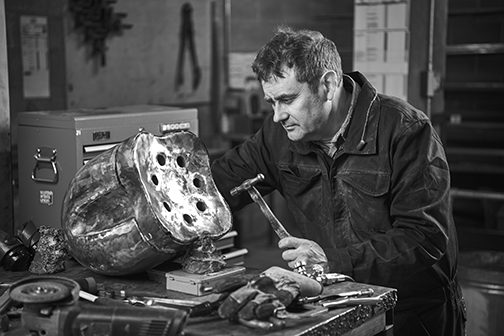
photo: John McKenzie
‘Carbon Capture’, a brand new copper sculpture, has been selected for the 199th Royal Scottish Academy Annual Exhibition 2025. These photographs were taken by fine art photographer John McKenzie during the construction of the sculpture in Glasgow Sculpture Studios’ metal workshop; a process of folding, shaping, brazing and surface finishing.
The RSA annual exhibition runs from Saturday 3rd May to Sunday 8th June at the RSA, The Mound, Edinburgh.
RSA 199th Annual Exhibition
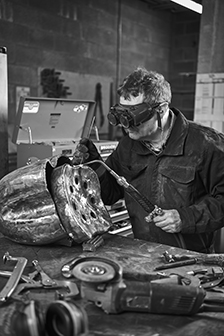
photo: John McKenzie
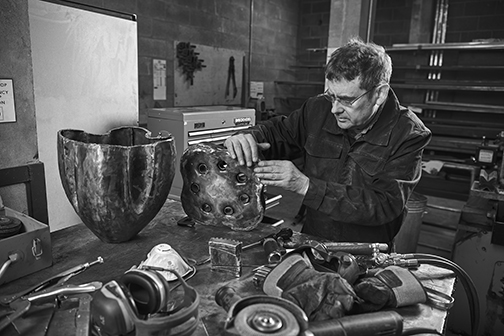
photo: John McKenzie
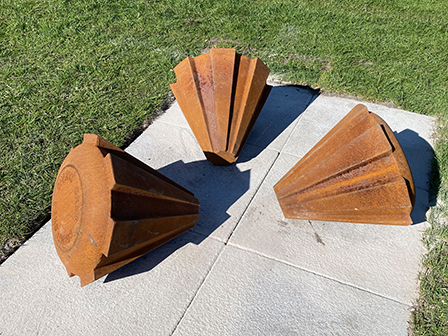
In March 2025 five extra cast iron cog sculptures were sited at two locations in Tillydrone, Aberdeen, commissioned by the Tillydrone Gateway Project, as an extension to the original commission by the River Don. Two are sited at the entrance to the Tillydrone Campus, the area’s community hub, and three in nearby St Machar Park.
Tillydrone Campus is a community centre, also home to the local library and a great cafe where the two sculptures sit just outside the window at the front entrance. Words on these two cogs were chosen through suggestions from the local community.
The other three are in St Machar Park. On one side of the park the backdrop is the University of Aberdeen’s Zoology Building, a well-known brutalist building favoured as a film location. Words were chosen to reflect the natural and industrial history and identity of Tillydrone, as with the five at the original site, symbolising the seeds of Tillydrone’s natural, historic and social identity. They were cast in iron at Northfield Foundry, Devon, with excellent finishing work by Blueton in Denny. It’s been an absolute pleasure to work with, and for, the Tillydrone community, and Jane, Susan and Sean of the Tillydrone Gateway Project who managed the whole project so well.
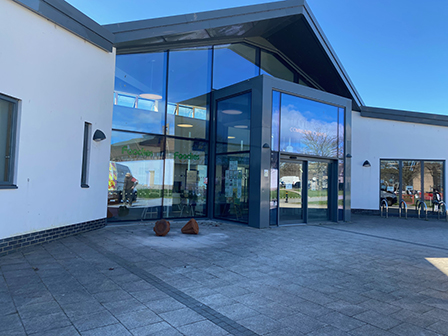
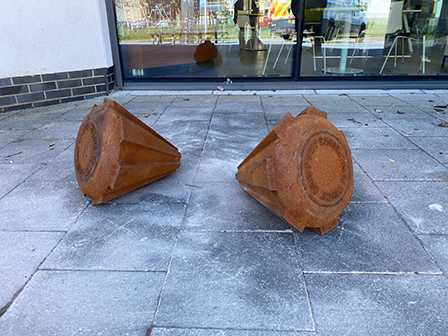
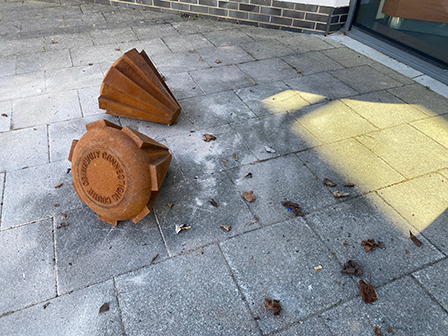
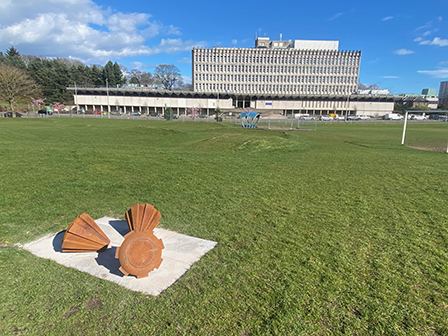
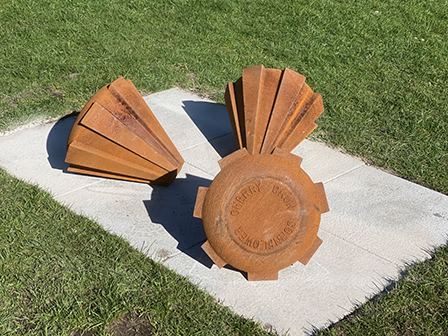
7 November 2024
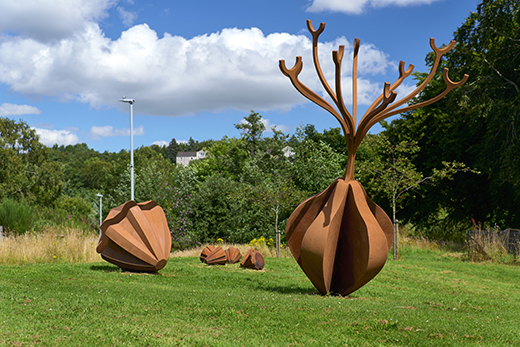
photo: John McKenzie
In May 2023 I completed “The Tillydrone Tops” for the Tillydrone Gateway Project on community land by the River Don in Aberdeen. Working with fabricators Blueton in Denny, this ascending series of sculptures were created to encapsulate the spirit of Tillydrone and moves from small cast iron pieces through to larger sculptures made of Cor-ten steel. The works suggest a set of spinning tops, growing forms that closely reference key features of Tillydrone’s social, industrial, and natural identity.
The ‘Tops’ indicate the mills that took their energy for shuttling, spinning, and weaving, from water wheels powered by the river. Today the nearby Hydro creates energy from the same source. Paper and textile mills used to be sited along this part of the river Don and as such, the river is an essential part of Tillydrone’s existence.
The flora and fauna of the banks of the Don inspired elements that weave into the forms of the sculptures – a process of growth that begins with the small cast iron ‘seedlings. These cogged forms have the feel of seed pods – the founding points for the other works – and the text on them highlights specific aspects of Tillydrone, past and present.
The use of cast iron reflects the industrial legacy of Tillydrone, echoed in the rich, earthy tones of the Cor-ten steel, as well as giving a sense of the cycle of nature along the river.
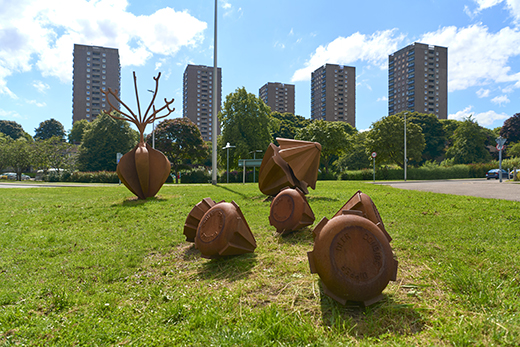
photo: John McKenzie
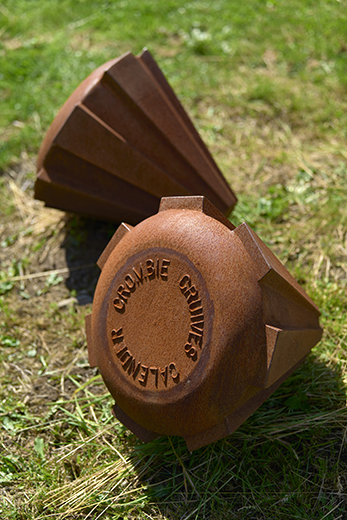
photo: John McKenzie
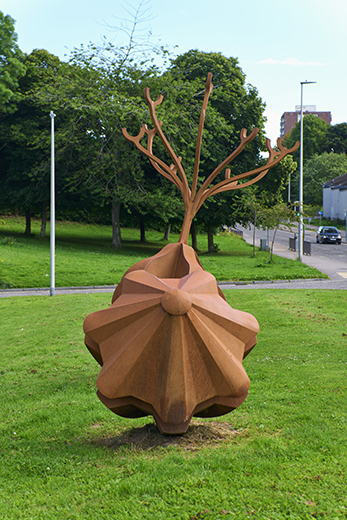
photo: John McKenzie
24 January 2022
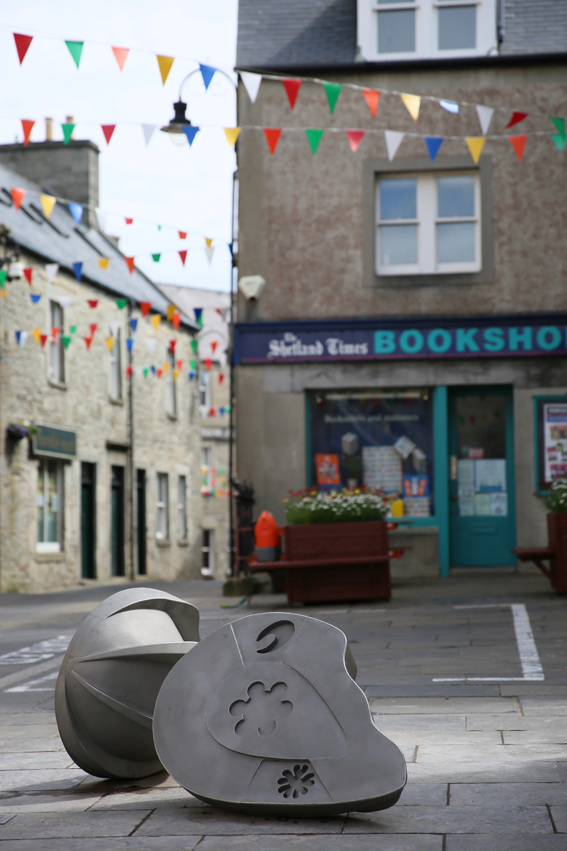
Storm Cargo on Commercial Street. Photo: Jenny Leask
I have completed ‘Storm Cargo’, a sculpture for Lerwick, Shetland as part of the contemporary LOCUS Public Art Trail. Working with fabricators Malakoff Engineering in Lerwick, it was installed on 3rd July 2021. ‘Storm Cargo’ is made of stainless steel and consists of two halves and is broadly inspired by the shape of a guillemot’s egg. One half is more upright or ‘on its side’ and close to it, the other half is in a more prone position. The outer surfaces of the work depict tides, waves, coast and landscape, along with ’sixareen’ Shetland boat construction. The egg is sliced open to reveal a cargo of elements that make up Shetland: a Scatness wheelhouse and a hearth stone from Jarlshof, Edmonston’s chickweed from Unst and Fort Charlotte, compass navigation and marine engineering, all as deep cut symbol reliefs. The two oldest ones are cut deepest, the next two less so, and the most recent with the lightest ‘footprint’. The inner plates also angle and wedge, creating a dynamic surface reflecting the stone construction and landscape at Scatness and Jarlshof.
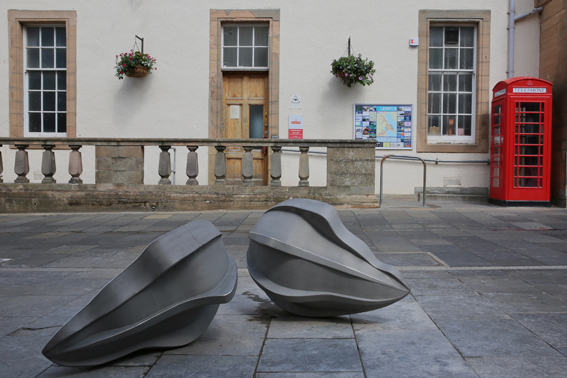
Storm Cargo. Photo: Jenny Leask
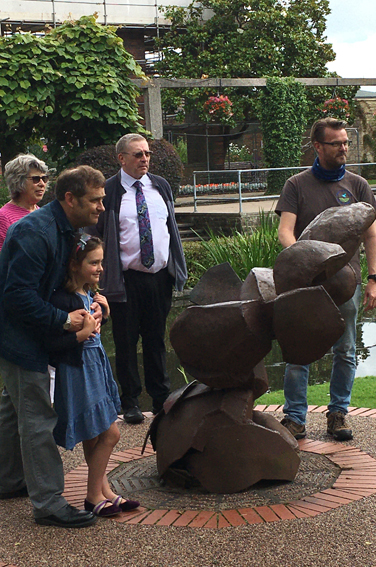
Celebrating a new plaque for my old sculpture ‘Turtle Storm’, 25 years in Queens Park, Swindon. One from my degree show and the first piece of work I sold.
Many thanks to Linda Kasmaty, and all at Friends of Swindon Museum and Art Gallery, as well as South Swindon Parish Council and Angela Atkinson, for their support and enthusiasm in organising such an enjoyable day back in July.
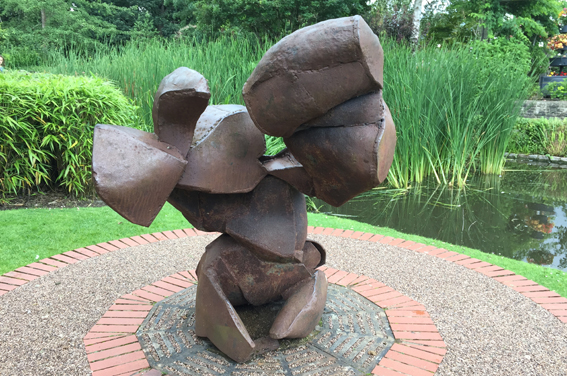
Turtle Storm, Queen's Park, Swindon
14 January 2022
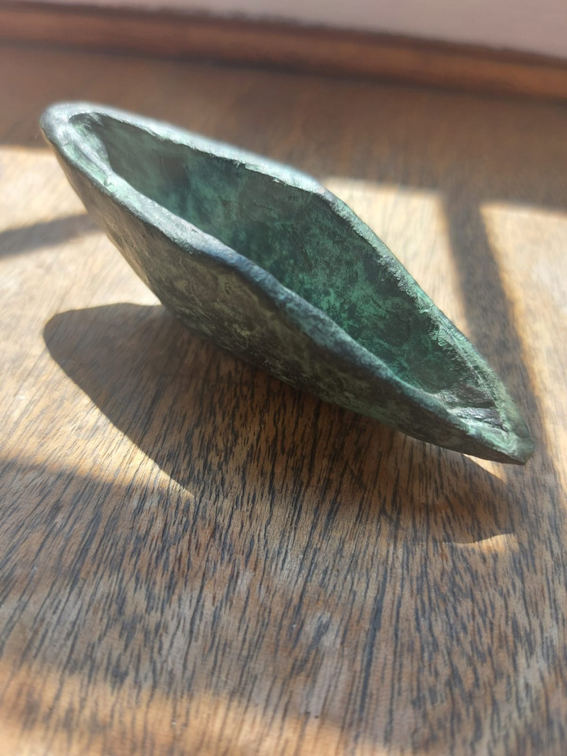
Vessel
From July to September 2021, I took part in the ’10gram Challenge’ group exhibition at Dora House, the HQ of the Royal Society of Sculptors in South Kensington, London. Vessel, like all 200-odd contributions from members, was made from 10 grams of wax, then cast into bronze by the Milwyn Foundry, Surrey. The idea for the project was conceived during the first Covid lockdown, by RSS member and sculptor, Alex R T Davies, who runs the foundry.
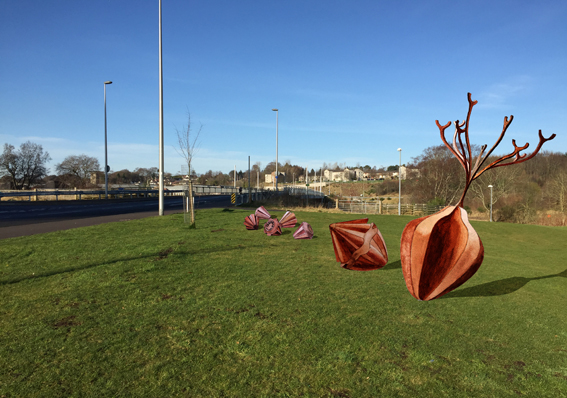
The Tillydrone Tops
In 2021, I was invited to submit a design proposal for the Tillydrone community in Aberdeen as part of the Tillydrone Gateway Project. The proposed works are an ascending series of sculptures, from small cast iron pieces to a large Cor-ten sculpture, ranging in height from 0.42m to 3.5m. The title, The Tillydrone Tops, suggests in the sculptures a set of spinning tops, growing forms that closely reference key identifying features of Tillydrone’s social, industrial and natural history. Paper and textile mills used to be dotted along this part of the River Don, its northern edge. As such the river is an essential part of Tillydrone’s existence as the mills took their power from shuttling, spinning and weaving from water wheels powered by the river, and it is still the case today with the Hydro creating energy from the river. This sense of energy and movement is expressed in the rising series of shapes that grow up and out with a sense of new growth.
23 May 2018
The first of the twin Chestnut Seed sculptures has been installed at the Broad Street entrance to the town, following fabrication at the brilliant Blueton. Referencing the 450 year old Spanish Chestnut tree in Herbertshire Park, across the River Carron in Dunipace, the stainless steel sculpture symbolises growth and renewal in Denny today. In its centre is an acrylic block, recording drawings by local primary school children, and their interpretations of the history, environment and contemporary life in Denny and Dunipace today.
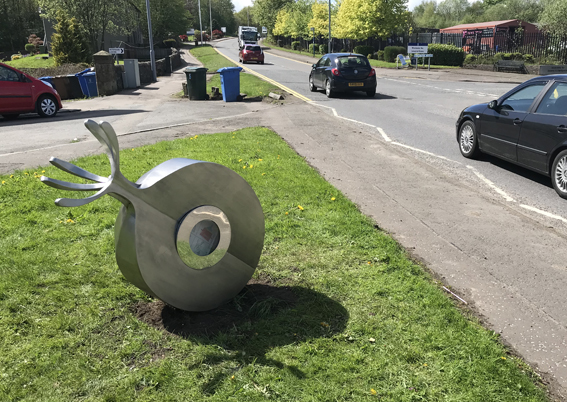
Chestnut Seed sculpture installed at the Broad Street entrance to Denny
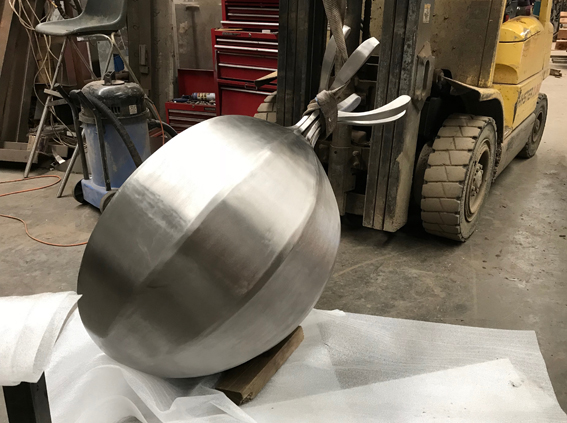
Chestnut Seed under construction at Blueton, Denny
26 January 2018
The series of town centre Treasure Trail works are now being installed. Made in collaboration with Specialised Castings (cast iron) and Blueton (oak and stainless steel), all have taken shape in Denny itself. Here are images of my 1:3 scale models and ‘Discovery Oak’, ‘Bridge’ and ‘Acorn Lamp’ undergoing meticulous engineering and craftsmanship at Blueton. ‘Discovery Oak’ refers to the stern post of Scott’s ship Discovery, which came from an oak tree in Herbertshire Park, Dunipace. ‘Acorn Lamp’ refers to the mining industry of Denny and continues the theme of nature and in particular oak, running through Denny and the River Carron. The river is also referenced in ‘Bridge’, symbolising Denny Bridge and its predecessors such as Stripeside Bridge, that span and reflect in the river. The mirror reflection also represents the twin existence and identities of Denny and Dunipace.
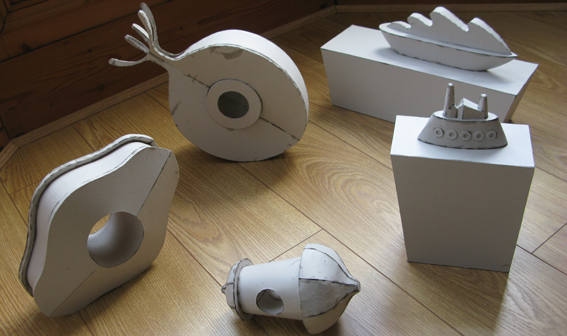
Denny Treasure Trail scale models
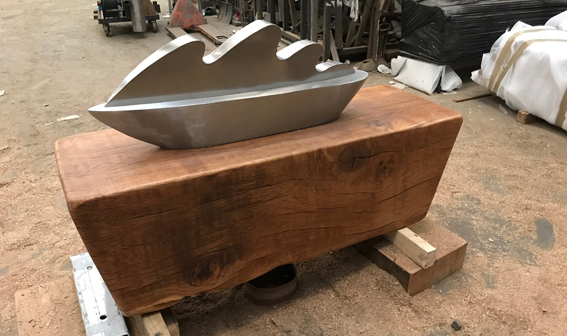
'Discovery Oak' in progress at Blueton, Denny
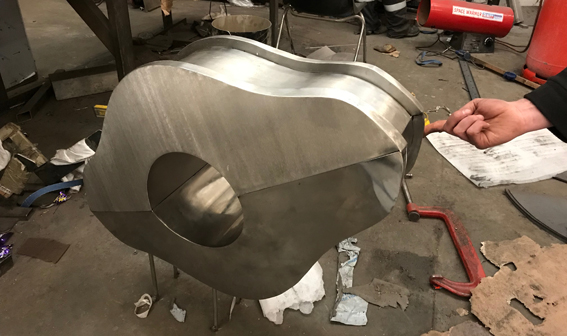
'Bridge' in progress at Blueton, Denny
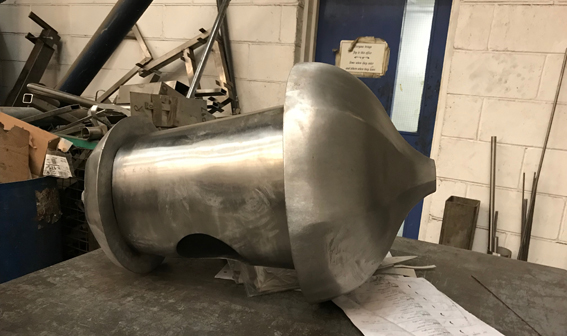
'Acorn Lamp' in progress at Blueton, Denny
← Older posts




























